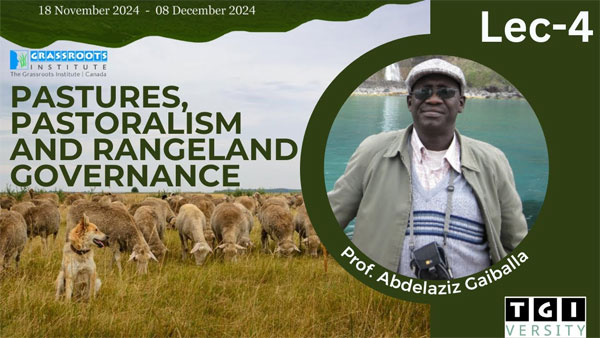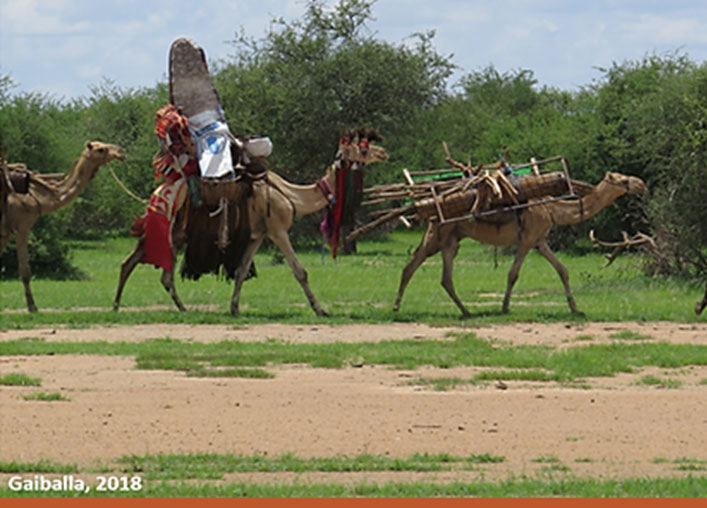Unit 2.1: Pastoralism And Transhumance
Instructor: Prof. Abdelaziz Karamalla Gaiballa
In this Unit 2.1, we will understand the pastoralism and problems and issues of challenging, understanding facts and misconceptions regarding pastoralism and to create a sound understanding and clear picture about this.
2.1.1 Pastoralism
Participatory Exercise in Forum P-001
The exercise for the students is focusing on challenges related to Pastoralism and transhumance. Before going to the exercise, let us review the following:
Pastoralism is a land use system associated with the use of natural rangelands by pastoralists, for whom livestock keeping is economically and culturally important, viable and dominant. Pastoralism, too, is a main livelihood practice in many areas of the world. It is also defined as a specialization to take advantage of the characteristic seasonal variability of drylands land environments where the distribution of resources (nutrients and water for the livestock) is both unpredictable and in short-lived concentrations (Saverio et al., 2013).
Pastoralism survived in all parts of Southern Europe mainly in form of movements of humans with their sheep and goats mainly in the mountains of Mediterranean Europe and pastoral systems with various gradients of dependence on lands. In Horn of Africa more than 30 million pastoralists are living and adopting pastoralism. It is commonly agreed that Pastoralism is facing increasing challenges which make it a difficult way of living and a system at a cross roads, and it also raise many questions about its sustainability. These issues are continuously raised in spite of the fact that pastoralism still has a major contribution to economy, food security and environment and with no foreseen practical substitute yet. This situation results in different controversial ideas and different views and questions that usually remain with no satisfactorily answers.
Task and Instruction for Students
To understand the deeply the concept of pastoralism and issues that challenge pastoralism, all the students are advised to enter Forums and click topic P-001. There, every student is requested to write at least one problem or issue the pastoralism is facing in his/her country or region.
Answers/Feedback of Students:
M2 Responses Students1
Essential Watch (Video)
In this video Ian Scoones, a professorial fellow at IDS Sussex (UK) draws on his years of research and experience to answers the question 'What is Pastoralism?'
This video is about the importance and challenges facing pastoral way of life.
Copyright: YouTube
Livestream Zoom Session by Prof. Abdelaziz Karamalla Gaiballa
Topic: Participatory Discussion on: Pastoralism and Transhumance: Importance and Challenges.
Date: 25 November 2024
Time: 5 pm Central European Time (CET)
Zoom Link: 844 2145 4270
Recorded Video: https://www.youtube.com/watch?v=gigm7Z_MprM
Zoom Chat Text | PPT File
Task for Instructor/Facilitator
Instructor/Facilitator will closely follow the activity of students about the topic in the Forum P-001. The issues understood and challenges discussed or issues suggested or highlighted by students, to be discussed right in the Forum, but also are taken to be listed in this section.
Problems and Issues Highlighted by Students in Forum P-001
Some of the indicative challenges, problems and issues related to pastoralism are written hereunder for further readings and discourse.
- Pastoralism is taken as an old and non-productive system.
- Decision-makers are not well sensitized about pastoralism.
- Pastoralism is looked at as a movement of animals and not as a land use system.
- Pastoralism is looked at as a system that is not suitable for current conditions.
2.1.2 Transhumance
Before we go in details under this topic, let us share understanding of pastoralism as a land use and transhumance as a focal practice of pastoralism.
Transhumance is a form of pastoralism where herders move in a regular and seasonal pattern. It is a form of pastoralism where herders move in a regular and seasonal manner looking for feed and good environment for livestock herding. In many cases, only the livestock and a few key individuals migrate, while the majority remains at base location. Example for this is the movement to higher pastures during the summer and lower valleys in the winter.
Pastoralism, as a practise of extensive grazing on rangelands for livestock production, is an important economic and cultural way of life for between 100 and 200 million people throughout the world. Extensive pastoral production systems cover about 25% of the earth’s terrestrial surface. Many pastoralists can be found in Africa, however pastoralism is also practiced in dry and sub-humid lands in the Middle East, South and East Asia, South America and Europe (CBD, 2010). It is the main economic activity of the people of Mongolia and the ex-Soviet republics of Central Asia, as well as in huge regions of China and Russia.
This practice is also prevalent in mountainous highlands and valleys. Mountain pastoralism characterized by a vertical stratification of resources by altitude, which permit herders to move animals from low lands cool season to high lands warm season to escape the extreme temperature and precipitation that might harm their animals. Also they may practice farming there (Montero, et al., 2009).
Two contrasting views about sustainability of pastoralism have remerged, with one of them considering pastoralism as most relevant land use practice and contribute significantly to food security and national economics, in addition to its role in environmental conservation (Gaiballa and Nanacy, 2016). The other view considers the existing pastoral production system is no longer capable to continue within the prevailing condition and the expected rhythm of change. This trend of thinking has been greatly influenced by the idea of the tragedy of the commons of Garret Hardin (Hardin, G. 1968). It also seems influenced by the wide spread views that rangelands are greatly degraded by the overgrazing that imposed by increasing number of livestock. The ideas went further in thinking that the production system that depend on commercial ranches blocks and grazing rotations can be the solutions to secure provision of livestock products

Photo: Mobility in South Darfur of Sudan
Some look at pastoralists as poor people. Not all of them are poor: those of Europe and Asia increasingly exploit niche markets for specialist goods and organic products, facilitated by generally high levels of education, strong political representation and good access to a wide range of services. Despite this resurgence of pastoralism in developed countries, developing country pastoralists find themselves cut off from services and markets, at risk of having their land confiscated, excluded from decision making and increasingly unable to avert destitution. Number of different views about the context of using related term and about what meant (Gaiballa and Nancy, 2016).
There are signs that pastoralism is now receiving a growing interest, where according to UN Agenda 2030, developing technical and policy programs on pastoralism – nationally and internationally will help in valuing its benefits of pastoralism. This will also help to mitigate the negative impacts stemming from neglect of this useful production system. On the other hand, the United Nations General Assembly (UNGA) in New York has declared 2026 the International Year of Rangelands and Pastoralists (IYRP). It recognizes that: “Pastoralism is a dynamic and transformative livelihood linked to the diverse ecosystems, cultures, identities, traditional knowledge and historical experience of coexisting with nature”.
Essential Watch (Video)
The video shows the importance of and challenges facing pastoral way of life.
By African Development Solutions (Adeso).
Copyright: YouTube
Wrap Up the Unit 2.1: Make Notes and Post in Forum P-001
- In your short note, please highlight what new thing you have learnt from lesson written above in Unit 2.1?
- Have you observed any challenges misconception and lack of real evaluation for pastoralism and transhumance in your area or region? Explain in short.
Essential Further Readings:
Gaiballa, A. and Abdalla, N. (2018). Understanding the Pastoral Production System
of East Africa. In: Pastoralism and Climate Change in East Africa, 33–47. Dar es Salaam: Mkuki na Nyota Publishers. https://shorturl.at/Yakfh
Abdalla, N. and Gaiballah A. (2018). “The Impacts of Climate Change on the
Pastoral System in East Africa.” In Pastoralism and Climate Change in East Africa, edited by Pius Zebhe Yanda and Claude Gasper Mung’ong’o, 49–66. Nairobi: Mkuki na Nyota Publisher.
Saverio, K., Omer, Hassan E., Young, H., Ahmed, S.M., Babiker, O.M., Ismail,
M.A., Hassan, A. and Azhari, B. (2013). Standing wealth. Pastoralist Livestock Production and Local Livelihood in Sudan. Khartoum: Feinstein International Center, Tufts University. https://fic.tufts.edu/publication-item/standing-wealth/
Nori, M. and Farinella, D. (2020). Migration, Agriculture and Rural Development:
IMISCOE Short Reader. Springer. http://hdl.handle.net/1814/67198
Optional Further Reading:
Behnke, R. (1992). New directions in African range management policy. Pastoral
Development Network Paper 32c. Overseas Development Institute, London. https://www.researchgate.net/publication/265398405_New_Directions_in_African_Range_Management_Policy
CBD (2010). Pastoralism, Nature Conservation and Development: A Good practice
Guide. Secretariat of the Convention on Biological Diversity, Montreal, Canada. https://www.cbd.int/development/doc/cbd-good-practice-guide-pastoralism-booklet-web-en.pdf
Hardin, G. (1968). The Tragedy of the Commons. Science, 162: 1243-48. https://www.science.org/doi/10.1126/science.162.3859.1243
Markakis, J. (2004). Pastoralism on the Margin. 2004. Minority Rights Group
International, London, UK. https://minorityrights.org/app/uploads/2024/01/download-149-pastoralism-on-the-margin.pdf
Montero, R.G, John, M. and Chetan, S. (2009). Mountain Pastoralism. Nomadic
People, 13(2). https://www.jstor.org/stable/43123847
Nori, S., and Gemini, M. (2011). The Common Agricultural Policy Vis-à-Vis
European Pastoralists: Principles and Practices’. Pastoralism: Research, Policy and Practice, 1(1): 27. https://doi.org/10.1186/2041-7136-1-27.






